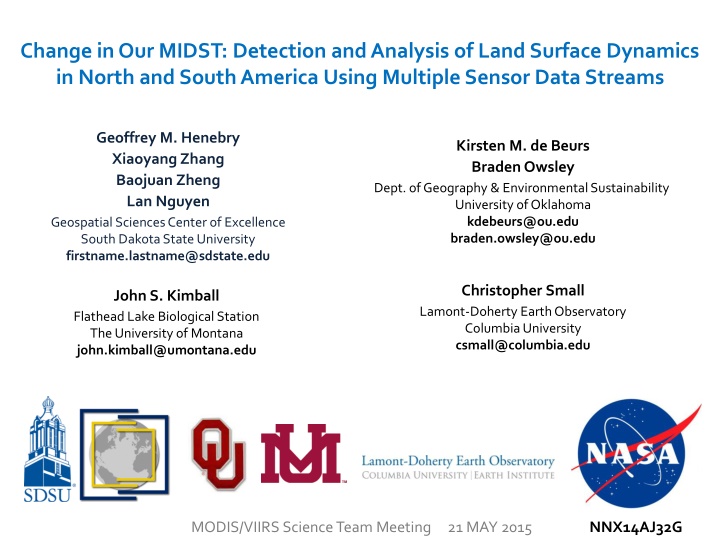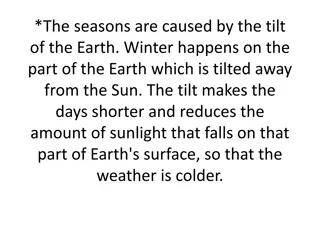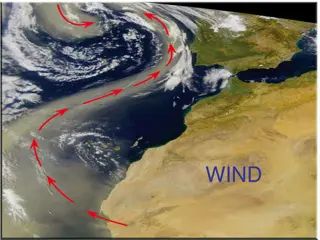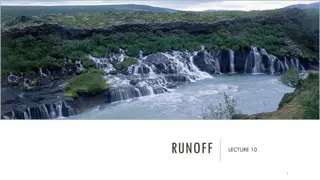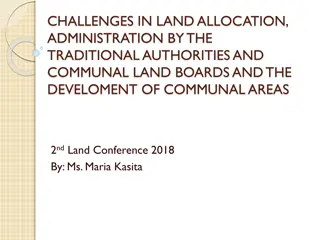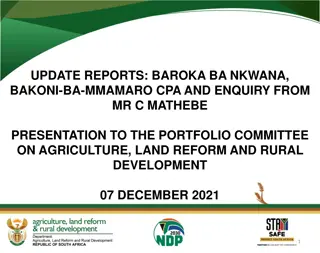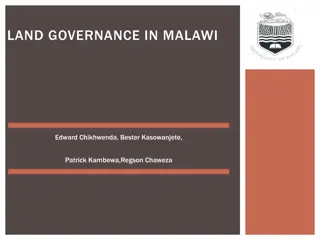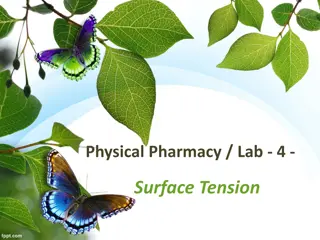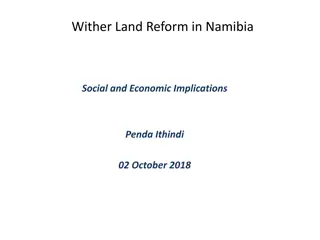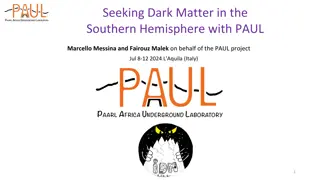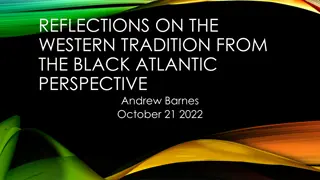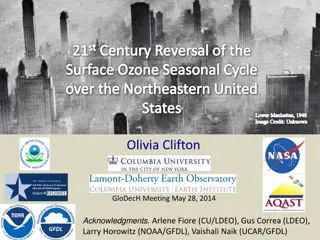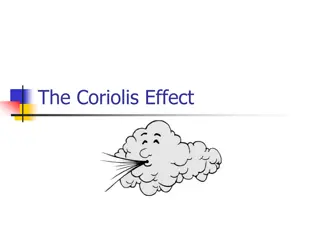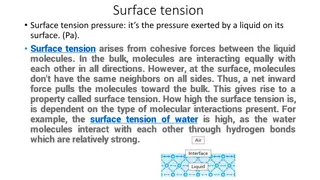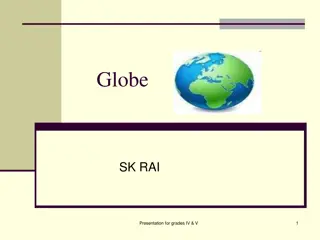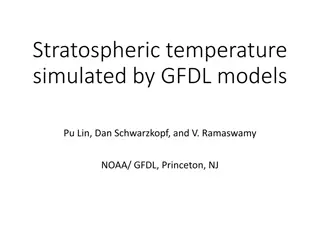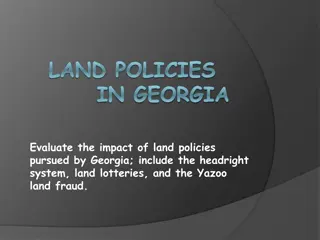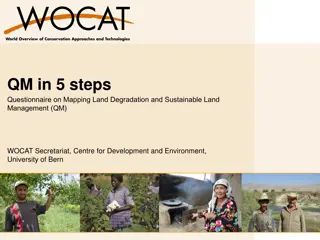Analysis of Land Surface Dynamics in the Western Hemisphere
This project focuses on detecting and analyzing changes in vegetated land surfaces in North, Central, and South America, along with major islands in the Caribbean Sea. Multiple sensor data streams are utilized to quantify and localize change, attributing significant trends to direct human impacts. The process involves detection, quantification, assessment, attribution, and projection of consequences. The goal is to understand environmental processes and drivers of change in the Western Hemisphere.
Download Presentation

Please find below an Image/Link to download the presentation.
The content on the website is provided AS IS for your information and personal use only. It may not be sold, licensed, or shared on other websites without obtaining consent from the author.If you encounter any issues during the download, it is possible that the publisher has removed the file from their server.
You are allowed to download the files provided on this website for personal or commercial use, subject to the condition that they are used lawfully. All files are the property of their respective owners.
The content on the website is provided AS IS for your information and personal use only. It may not be sold, licensed, or shared on other websites without obtaining consent from the author.
E N D
Presentation Transcript
Change in Our MIDST: Detection and Analysis of Land Surface Dynamics in North and South America Using Multiple Sensor Data Streams Geoffrey M. Henebry Xiaoyang Zhang Baojuan Zheng Lan Nguyen Geospatial Sciences Center of Excellence South Dakota State University firstname.lastname@sdstate.edu Kirsten M. de Beurs Braden Owsley Dept. of Geography & Environmental Sustainability University of Oklahoma kdebeurs@ou.edu braden.owsley@ou.edu Christopher Small Lamont-Doherty Earth Observatory Columbia University csmall@columbia.edu John S. Kimball Flathead Lake Biological Station The University of Montana john.kimball@umontana.edu MODIS/VIIRS Science Team Meeting 21 MAY 2015 NNX14AJ32G
Our science question is broad: Where in the western hemisphere is the vegetated land surface changing significantly during the past 15+ years in response to direct human impacts? Broad scope of the Western Hemisphere: North, Central, and South America plus the 4 islands in the Caribbean Sea >9000 km2 Cuba, Hispaniola, Jamaica, Puerto Rico. Special focus on (1) megacities and major conurbations and (2) cerrado region of Brazil. 2
Multiple Indicators Detecting Significant Trends Multiple Indicators Detecting Significant Trends MIDST MIDST We are building an innovative system to use multiple sensor datastreams to quantify and localize change, characterize environmental processes, and examine the function of land surface change. examine the function of land surface change. We are building an innovative system to use multiple sensor datastreams to quantify and localize change, characterize environmental processes, and The process of change analysis is a sequence of tasks: i. detection of changes, ii. quantification of changes, iii. assessment of changes, iv. attribution of changes, and v. projection of the potential consequences of changes. v. projection of the potential consequences of changes. The process of change analysis is a sequence of tasks: i. detection of changes, ii. quantification of changes, iii. assessment of changes, iv. attribution of changes,and MIDST will implement solutions to the first three detection tasks and produce georeferenced polygons of significant trends from datastreams. MIDST will then evaluate plausible links of candidate drivers to polygons with one or more significant trends. 3
trend. Dictionary.com.Dictionary.com Unabridged. Random House, Inc. http://dictionary.reference.com/browse/trend(accessed: December 08, 2014). What do we mean by trend ? As a noun: 1. The generalcourseorprevailingtendency; drift: trends in the teachingof foreignlanguages;the trendof events. 2. style orvogue: the new trend inwomen's apparel. 3. the generaldirectionfollowedby aroad,river, coastline,orthelike. As a verb (used without object): 4. tohaveageneraltendency, asevents, conditions,etc. 5. totend totakeaparticulardirection;extend insomedirection indicated. 6. toemerge as apopulartrend; be currently popular: trending topicson the Internet; wordsthat havetrended this year. 7. toveer or turnoff inaspecifieddirection,asariver,mountainrange, etc.: The rivertrends towardthe southeast. 4
trend. Dictionary.com.Dictionary.com Unabridged. Random House, Inc. http://dictionary.reference.com/browse/trend(accessed: December 08, 2014). tend. Dictionary.com.Dictionary.com Unabridged. Random House, Inc. http://dictionary.reference.com/browse/tend(accessed: December 08, 2014). trend Word origin: before 1000; MiddleEnglishtrenden to turn, roll,OldEnglishtrendan; akin toOldEnglishtrinde ball, Dutch trent circumference,Swedishtrind round. tend Word origin: 1300-50; Middle Englishtenden < MiddleFrench tendre < Latin tendere to stretch, extend, proceed At root, the French-Latin tend implies directionality. At root, the Anglo-Saxon trend does not imply directionality. 5
Technical indication of a temporaltrend: Measurements over a specified period that, taken as a whole, indicate a prevalence toward different values at the extremities of the period. A temporal trend indicates change through time. A temporal trend is assessed looking backward in time. Statistical significance of the trend is a function of the duration of the measurement period, the temporal density of the measurements, the variation in the time series of values, and the user s criteria for significance. Seasonal Kendall (SK) trend test corrected for first-order autocorrelation: non-parametric statistical analysis generating exact significance values [de Beurs & Henebry 2004 GRSL, 2005 IJRS]. 6
Significant changes in northern S o Paulo and western Minas Gerais states in Brazil from 2001-2012 as revealed by 46 MODIS NBAR NDVI 8-day composites at 500m. Significance classes are overlaid on the average NDVI. Bright green indicates significant positive trends at p<0.01. Bright orange indicates significant negative trends at p<0.01. Application of a 3x3 median filter highlights the larger hotspots of significant change. Tan areas have been screened for low NDVI and low seasonality, corresponding to cities, towns, and settlements. 7
MIDST is running SK analyses on key gridded L3 environmental variables from multiple sensors on NASA s Terra and Aqua satellites: MODIS: 500 m, 1000 m, 0.05 , 8-day & monthly albedo, land surface temperature, land cover, land cover dynamics (land surface phenology), aerosol optical depth, evapotranspiration, snow cover, burned area, LAI/fPAR, GPP, and NDVI, EVI, and tasseled cap factors from NBAR. AMSR-E + AMSR2: surface air temperature, soil moisture, precipitable water vapor, fractional open water, vegetation optical depth. 25 km, 8-day & monthly AIRS: 1.0 , monthly temperature, water vapor, relative humidity, carbon monoxide at multiple pressure levels, and height, pressure, temperature of the tropopause. CERES: 1.0 , monthly shortwave, longwave, and net radiative fluxes at surface for clear sky and total sky, shortwave, longwave, and net radiative fluxes and albedo at top of atmosphere for clear sky and total sky. MOPITT: 1.0 , monthly retrieved carbon monoxide (CO) total column, retrieved CO mixing ratio profile at multiple pressure levels. and more! 8
To make biogeophysical sense of multiple trends, we will interpret (or constrain) them with reference to idealizedsurface radiation budget and surface energy balance to reduce the candidates for proximate causes of the changes. RN = SWDOWN*(1- ) + LWDOWN LWUP RN = G + SH + LE Consider the following environmental changes with urban expansion within an agricultural matrix: Increases in albedo, sensible heat flux, land surface temperature, air temperature, impervious surface area, boundary layer height, roughness length, aerosol optical depth, and carbon monoxide concentration; Decreases in vegetation indices, LAI/fPAR, GPP, latent heat flux, evapotranspiration, and surface moisture. 9
MIDST will evaluate detected significant changes in the vegetated land surface against 12 scenarios capturing most common land cover changes: (1) (2) (3) (4) (5) (6) recovery from fire (7) intensification of row crop agriculture (8) intensification of grazing (9) plant pests & diseases (10) extreme weather events including flooding, hail, and wind (11) forest harvesting (12) geological natural hazards including volcanoes, earthquakes, and landslides urbanization conversion to/from crops onset of drought recovery from drought fire 10
Detected Change = (EV1, EV2, EV3, EVn) MIDST will use four different but complementary statistical modeling approaches to link change polygons with candidate drivers: i. ii. iii. iv. Regularized Generalized Canonical Correlation Analysis (RGCCA v1.0) Generalized, Unbiased, Interaction Detection and Estimation (GUIDE v15.0) LOgistic regression Trees with Unbiased Selection (LOTUS v2.3) Probabilistic Mixture Modeling of Land Surface Phenologies (PMM-LSP) Training using known changes: increases in impervious surface area, areas of burns or floods or droughts, areas of changing crop type or management, etc. 11
Lets look at trends from MOPITT & AIRS time series Carbon monoxide (CO) results from incomplete combustion from mobile and stationary sources in urban areas indicator of urban metabolism from wildfires in remote areas indicator of disturbance from agricultural prescribed burning indicator of land management or crop type and chemical interactions with hydroxyl (OH) radical. CO lifetime in boundary layer is a few weeks to a couple of months. AIRS CO channels are more sensitive in upper and mid troposphere (300 600 hPa). MOPITT TIR retrievals are sensitive in mid troposphere and in lower troposphere, when sufficient thermal contrast between surface and lower atmosphere exists. Deeter et al. 2007. Sensitivity of MOPITT observations to carbon monoxide in the lower troposphere. JGRA doi: 10.1029/2007jd008929 Warner et al. 2007. A comparison of satellite tropospheric carbon monoxide measurements from AIRS and MOPITT during INTEX-A. JGRA. doi: 10.1029/2006jd007925. Worden et al. 2013. Decadal record of satellite carbon monoxide observations. ACP doi: 10.5194/acp-13-837-2013. 12
Comparable low levels of CO over remote areas 400 300 MOPITT: CO mixing ratio (ppbv) NE CO Average annual CO above 5 remote (non-MSA) areas in CONUS 200 NM UT OR 100 ID MT 0 800 hPa 700 hPa 600 hPa 500 hPa pressure level 400 CO mixing ratio (ppbv) 300 AIRS: NE CO Average annual CO above 5 remote (non-MSA) areas in CONUS 200 NM UT OR 100 ID MT 0 800 hPa 700 hPa pressure level 600 hPa 500 hPa 13 Zheng et al. in prep
Discrepancy between sensors where surface CO is high 400 New York MOPITT: Average annual CO above the 10 largest MSAs in CONUS Los Angeles 300 CO mixing ratio (ppbv) Chicago Dallas 200 Houston Philadelphia 100 Washington, DC Miami Atlanta 0 surface 900 hPa 800 hPa 700 hPa 600 hPa 500 hPa Boston pressure level 400 New York AIRS: Los Angeles 300 CO mixing level (ppbv) Average annual CO above the 10 largest MSAs in CONUS Chicago Dallas 200 Houston Philadelphia 100 Washington D.C. Atlanta Miami 0 Boston surface 925 hPa 800 hPa 700 hPa 600 hPa 500 hPa 14 pressure level Zheng et al. in prep
1 Significant decreases in CO at surface in each of the 10 largest MSAs during the EOS era 2 3 4 5 15 Zheng et al. in prep
6 Significant decreases in CO at surface in each of the 10 largest MSAs during the EOS era 7 8 9 10 16 Zheng et al. in prep
To conclude I want to show you the preliminary MIDST web interface, which currently hosts eight variables derived from MODIS at 0.05 for 2000-2014: MCD43C4 8-dayNadir BRDF-Adjusted Reflectance (NBAR) calculated [1] NDVI, [2] EVI, Tasseled Cap [3] Greenness, [4] Brightness & [5] Wetness MOD11C2 8-day Land Surface Temperature for [6] Day & [7] Night MOD16A2 [8] Monthly Evapotranspiration http://tethys.dges.ou.edu/GlobalChange/ Significant (p<0.01) positive changes appear in blue. Significant (p<0.01) negative changes appear in orange. 17
